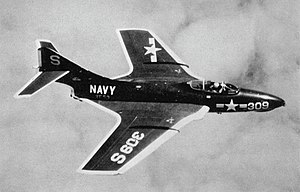
Back Grumman F-9 Cougar Afrikaans Grumman F-9 Cougar Catalan Grumman F-9 Cougar Czech Grumman F-9 German Grumman F9F Cougar Spanish گرومن اف-۹ کوگر Persian Grumman F-9 Cougar Finnish Grumman F9F Cougar French גראמן F-9 קוגאר HE F-9 Cougar ID
| F9F/F-9 Cougar | |
|---|---|
 Grumman F9F-6 Cougar, 1952 | |
| General information | |
| Type | Fighter aircraft |
| National origin | United States |
| Manufacturer | Grumman |
| Status | Retired |
| Primary users | United States Navy |
| Number built | 1,988[1] |
| History | |
| Introduction date | December 1952 |
| First flight | 20 September 1951 |
| Retired | 1974 (US Navy) |
| Developed from | Grumman F9F Panther |
The Grumman F9F/F-9 Cougar is a carrier-based jet-powered fighter aircraft designed and produced by the American aircraft manufacturer Grumman.
It was developed during the early 1950s on behalf of the United States Navy (US Navy) and United States Marine Corps (USMC), which were keen to quickly introduce a naval fighter equipped with a swept wing. Grumman's design team decided to adapt its earlier F9F Panther, replacing the straight wing of the Panther with a new swept wing. Thrust was also increased with the installation of a newer and more powerful engine. Nevertheless, the aircraft remained limited to subsonic speeds. The first prototype (XF9F-6), which was produced by modifying an existing Panther, performed its maiden flight on 20 September 1951. The Navy considered the Cougar to be an updated version of the Panther, despite having a different official name, and thus Cougars started off from F9F-6.
During December 1952, the F9F-6 was introduced to service, VF-32 being the first squadron to receive the type; while developed at a relatively rapid pace, the Cougar's arrival was too late for it to engage in active combat during the Korean War. While initial production aircraft were powered by a single Pratt & Whitney J48 turbojet engine, the F9F-7 were furnished by an Allison J33 powerplant instead. In the mid 1950s, the improved F9F-8 was introduced, which had a lower stall speed, improved handling when flown at high angles of attack, and increased range. The twin-seat F9F-8T was procured by the US Navy to perform various forms of training. The F9F-8P photo-reconnaissance variant was created by converting existing F9F-8s; most of the modifications were made to the aircraft's nose.
On 1 April 1954, US Navy Cougars established a new transcontinental crossing record. The US Navy's flight demonstration team, the Blue Angels, adopted the type in place of its Panthers. The Cougar gained a favourable reputation as a highly maneuverable and easy to fly aircraft. The only foreign air service that operated the Cougar was the Argentine Naval Aviation. The F9F-8 was withdrawn from front-line duties during the late 1950s, having been replaced by more capable aircraft such as the F11F Tigers and F8U Crusaders. While the Naval Reserves flew Cougars into the mid-1960s, only the TF-9J trainer model saw actual combat, having been deployed as a Forward Air Control aircraft during the Vietnam War. Following its withdrawal from active service, many F9F-6s were used as unmanned drones for combat training, designated F9F-6D, or as drone controllers, designated F9F-6K.
- ^ Francillon 1989, p. 342